In his piano method of 1828, Hummel devotes two chapters to remarks concerning problems of performance, and supplements those remarks with several pages of annotated musical examples taken in the main from his previously published Piano Concerto in A Minor.1 This portion of the method alone constitutes an important contemporary document which should be of inestimable value (but has not necessarily been used to fullest advantage) in assessing a number of different aspects of early nineteenth-century performance practice.
As first hand information provided by the composer himself, this material cannot be challenged on the basis of external considerations—such as a possibly faulty memory or a generally unreliable character—as, for example, Schindler's after-the-fact, second hand descriptions concerning Beethoven's manner of performance might be. Furthermore, the impressive credentials of the man who has left us this store of information lend added weight to its worth; not Beethoven himself, to be sure, but a reasonably respected colleague and sometime rival, a student of Mozart in his boyhood, and a composer in his own right whose works were to exert their share of influence on the young Schubert, who in turn would become an ardent admirer of that same younger master in his later years.2
Especially significant in a musical culture like our own which places such blind trust in the presumed finality of some hallowed "Urtext Authority," Hummel's words and examples offer a fascinating glimpse into the dark and uncertain worlds that lie beyond the limits of this imagined authority. They throw a new perspective on certain procedures of score preparation that may have been taken for granted by composers of Hummel's period, procedures that may have escaped our attention without the example, such as this one, of Hummel at hand. They suggest that for a composer like Hummel, a changing musical context alone was considered sufficient indication to guide the performer to a proper interpretation of his work without the need for insertion into the score of continuous verbal clarification in the form of markings and remarkings of tempo, expression, and the like.
Hummel's words and examples are also significant in that they offer incontrovertible evidence that he himself did incorporate a fair measure of tempo modification in his performance of his own works. This fact assumes even greater significance when one considers that as a performer Hummel was generally conceded to have been one of the more conservative players of his time. Thus, ironically, the trustworthy evidence provided by Hummel may in the end serve to bolster the questionable testimony mentioned above, left us by Schindler in connection with Beethoven's performance style.
The fact that the method was not published till 1828 should not lead to a hasty conclusion that it thereby loses all relevance to the age of Schubert and Beethoven. From his own correspondence we know that Hummel started work on this project many years earlier—at least as early as 1821—and the volume was completed three years before its publication in 1825.3 Furthermore, if we can trust Schindler on this count alone, we have evidence that Beethoven examined the work in manuscript and shook his head over its inconsequentiality.4
Beethoven's negative reaction need cause no surprise. As a contemporary English reviewer phrased it, the method's ponderous bulk of nearly 500 pages offered a "prospect somewhat similar to that of a journey through the Arabian desert."5 For Fétis the price of the volume was too high and its length too extended for it to be of much use to the French public.6 Around the same time Schumann joked about the volume's price and weight and complained that it contained a strange juxtaposition of useful insights together with a distressing quantity of "useless matter stifling to the imagination."7
But for posterity the two chapters on performance which command our attention here—together with their accompanying musical illustrations—may qualify as the oasis of Hummel's desert. Indeed, to me they appear without a doubt to be the most significant chapters of the entire treatise, by far more important and with implications more far-reaching than his instructions on the trill which have received more attention and—undeservedly, perhaps—have gained a notoriety in their own right whenever the question of Beethoven's trills comes up.8
Hummel entitles his performance chapters Vom Vorträge überhaupt and Einige Hauptbemerkungen, den schönen Vortrag betreffend (Concerning Performance in General and Some Remarks Concerning Beautiful Performance), and develops three main themes in them.9 The first concerns the inadequacy of words themselves in any attempt to capture the essence of certain musical problems. The second calls for moderation in all aspects of performance. The third lays stress on the fact that those areas of performance which may be more or less satisfactorily treated in words are best exemplified in musical terms by the extremes of movement implied by the designation of an allegro, or an adagio tempo marking.
In the opening statement of his first chapter, Hummel distinguishes between the concepts of "correct" and "beautiful" performance. He draws a further distinction between the idea of a beautiful performance and the idea of expressivity (Ausdruck) in performance. Of the three categories thus established, the author claims that it is possible only to describe and discuss "correct" performance in adequate terms, since it alone is concerned with the purely mechanical aspects of the art. Beautiful performance belongs to the domain of "the appropriate, tasteful, and pleasing"; at best, its precise attributes can only be hinted at in a most general and approximate manner. Finally, expressive performance (or more literally, expressivity in performance) is directly associated with the subjective nature of feeling; it has nothing to do with that quality which enables the player to communicate the essential emotions held by the composer ("was der Komponist für das Gefühl in sein Werk hat"). At the most, the precise nature of this expressivity may merely be intimated through a vocabulary so vague as to be virtually meaningless except for those who already have a firm grasp of the matter well in hand ("durch allgemeine Kunstworte, die wenig Bestimmtes haben, und eigentlich nur denen nützen, welche die Sache schon in sich haben").
The significance of the last statement should not pass without notice. It offers a cogent explanation as to why the typical Hummel score (along with those of other composers of his time) is relatively clean in its appearance. The performer who has "die Sache schon in sich" has no need of "allgemeine Kunstworte" (in the form of expressive markings) for further enlightenment. He understands the musical message on its own terms well enough. For those who do not grasp the sense of the musical communication, the "allgemeine Kunstworte" are meaningless anyway, and of no use.
Hummel makes the additional claim that expressivity in performance can neither be "taught" nor "learned" in the strict sense of those words; the most that can be hoped for is to arouse a sensitivity to this quality. Hence it causes little surprise to find him echoing C.P.E. Bach's dicta in his exhortations to his reader to miss no occasion to hear distinguished artists (especially "seelenvoller Sänger") as a means of educating the reader's taste.
Next Hummel stresses his "second theme" of moderation. The performer "should not try to replace his natural inner feeling with a visible outward one." Four points are cited for special condemnation here: (1) exaggerated bodily movements, (2) overuse of the pedal, (3) overembellishment of melodic lines by adding superfluous notes not indicated in the score, and (4) arbitrary and excessive stretching of the measure, continuously applied, i.e., tempo rubato. The original reads, "durch ein, bis zum Langweilen, jeden Augenblick angebrachtes willkührliches Dehnen (Tempo rubato)."
That Hummel uses the term tempo rubato is significant. Certainly, musicians of Mozart's generation did not use this term in such a manner, and some would argue that neither did Chopin. Despite the terminology used to describe the phenomenon, there is evidence that the early years of the nineteenth century witnessed a trend towards a freer manner of performance in general, and towards a less rigid observance of the beat in particular, than would have been palatable to the conservative-minded figures of the time.
Thus we find Louis Adam complaining in his piano method dating from around the turn of the century, that "quelques personnes ont voulu mettre en vogue de ne plus jouer en mesure, et d'exécuter toute espèce de musique comme une fantaisie, prélude, ou caprice." (Some persons have wished to start a vogue of not playing in time any more, and of performing every type of music like a fantasy, prelude, or caprice.)10 Not too many years later, in 1816, the Bohemian composer Václav Tomáek was to point to the example of Hummel as the rare exception for never losing tempo, "a virtue that is not practiced much in these times."11 (Italics mine.)
On the other hand, a closer reading of Hummel's statement regarding rubato quoted above might suggest that it is the exaggeration of the principle to which he is objecting, rather than the principle itself. In fact, by turning to his chapter on the metronome in this volume, one will find that the author calls attention to a common misunderstanding of the purpose of that instrument which results in an erroneous attempt to preserve a uniform beat throughout a composition, without allowing the least freedom for expression ("nur giebt es noch Viele, die bei der Anwendung des Metronoms irrig meinen, er sei dazu bestimmt, seinem gleichmässigen Gang des ganze Stück hindurch folgen zu müssen, ohne dem Gefühl dabei Freiheit zu lassen").12
In spirit these words are not too far distant from those of Weber when he wrote on a similar subject in his preface to the score of Euryanthe.13 But where Weber is more positive in his approach to the question of what liberties to allow to the performer, Hummel is generally more cautious; for every two steps forward, he usually takes one backwards. Thus in his discussion of the subject in the present chapter on performance, Hummel begins by reiterating his objections to the unwholesome forms of exaggeration just cited in his four points, and continues by reminding his readers of the requirement that everything be given its just due ("jeder Sache das zu geben, was ihr begührt").
Illustrating this point he introduces his final theme concerning the specifics of allegro and adagio performance with the cautionary remark that the performance of the one or the other must be executed in such a fashion that "not even the layman would have any doubt as to which is being played." Furthermore the allegro loses its brilliance and characteristic unity ("runde Einheit") when one draws out the tempo in an exaggerated manner, just as the adagio loses its grace and depth of character by over-ornamentation. Following these somewhat circuitous remarks, our author comes to his main point: he does not mean to convey the impression by them that there is never room to hold back in an allegro or to introduce an occasional decorative flourish in an adagio; but it must happen at the right place and without exaggeration. (Italics mine.)
Hummel's second chapter on performance problems ("Some Remarks Concerning Beautiful Performance") elaborates further the distinctions to be drawn between allegro and adagio performance. But first of all he digresses briefly on the need for one to be the master of one's fingers in order to achieve a good and beautiful delivery. Next he offers the advice that the player must study the character of the composition he is about to perform; otherwise he will be in no position to arouse in his listeners those feelings which the composer intended to convey. ("Der Spieler studire den Character des Tonstücke, sonst erweckt er den Zuhörern unmöglich dasselbe Gefühl, welches der Komponist durch seine Tondichtung zu erregen strebte.")
It is noteworthy that as Hummel touches on aesthetic considerations, he generally refrains from using his more prosaic terminology of Komposizione, Stück, or Werk, and uses more poetic terms such as Tonstück or Tondichtung. But he does not remain in the lofty regions of aesthetic speculation for long; he turns directly back to the more mundane considerations of the proper requisites of an allegro or adagio performance; in fact these appear to epitomize for him all the problems faced by a performer.
For instance, first of all the player must "determine whether he is dealing with an allegro or an adagio, because each of these movements demands its own mode of performance, and what is good for the one is harmful to the other." Next, the problems of each of these movements are isolated for more detailed consideration. "The allegro requires brilliance, strength, and a clear projection in its performance along with a pearly finger velocity. But the lyrical passages that may occur therein . . . may be taken with a certain breadth so as to allow for the appropriate expression. But one must not deviate too far from the basic tempo, because the overall unity would suffer thereby and the whole would assume too rhapsodic a character."
Hummel warns of the need to "establish a clearly defined beat right at the outset." One must avoid changing tempo from one measure to the next, too. But almost in the same breath he concedes that the player "may hold back in lyrical sections or within certain other passages." He further advises that the player should "occasionally stress the downbeat notes in passages," and almost as an afterthought he speculates that in this manner one will "keep himself to the beat, and any orchestra should find it easy to accompany him, too."14
As for the prerequisites of an adagio performance, "the adagio requires expressivity, songfulness, delicacy, and calm. Thus it stands in a somewhat contrary relationship to the allegro. . . . Adagio embellishments require more sweetness and delicacy than those of an allegro. They must charm the listener rather than shock him, and they should arouse a feeling of pleasure rather than one of surprise."
The futility of verbalization is suggested yet once again in Hummel's closing remarks in this chapter as he turns to the matter of applying the proper stress to the tones in a phrase. "Just as the stress of certain syllables or words is necessary in speech in order to make the sense of those words clear, or in order to impress the significance of their delivery on the hearer, so does a like situation obtain in music. In essence, it is precisely that same natural feeling which the true, sensitive musician carries within himself without need to have it shown him in an artificial manner." (Italics mine.)
At various points along the way of his discussion of allegro and adagio performance Hummel introduces the annotated excerpts from his concerto and refers the reader to them to illustrate his text. For example, in his discussion of allegro performance he directs the reader to Exhibit A ("Aus meinem A moll Konzerte, Op. 85") which contains the soloist's portion of the exposition from the first movement of that work. To illustrate the problem of executing a rallentando, the reader is referred to Exhibit B, which likewise contains passages from the concerto, along with an unrelated cadenza, specially composed for this purpose. Finally, Hummel's discussion of the adagio is illustrated by Exhibit C, which includes excerpts from the slow movement of the concerto and a concluding portion of the slow movement from his Sonata in D Major, Opus 106.
Before turning to a consideration of Hummel's musical examples, a word is in order concerning the general appearance of the typical Hummel score. First of all, one notices that it is not unusual for the composer to introduce frequent changes in his dynamic markings; but he appears to be much more sparing in his use of vocabulary for expressive markings. In this respect at least, his scores seem to resemble more closely those of Schubert or the early Beethoven than they would those of the late Beethoven or Weber. But of course notable exceptions might be found; adagio movements are generally more richly marked than allegros, and just as in Beethoven's case, Hummel's later scores would show an increase in his use of expressive markings.
For the rest Hummel does appear to employ a wider range of vocabulary than either Schubert or Beethoven in the markings found in many of the works of his mature years. Here, in addition to the usual terms which one might encounter in either a Beethoven or Schubert score, Hummel's directions are frequently broadened to include the vocabulary that was to find favor with the composers of the Romantic period; terms such as dolente, appassionevole, con anima, con duolo, risvegliato, armonioso, etc., turn up again and again.15
As one turns to the first movement of the Concerto in A Minor—either in its original printed version as given by Steiner, or in the version excerpted in the method—one finds no exception to the economy of markings just noted. In that portion of the soloist's exposition excerpted in the method, one finds a fair variety of dynamic markings along with a liberal sprinkling of different sorts of accentuation markings; but within the whole of the quotation as it is given in the method's Exhibit A, one finds only two expressive markings: dolce and risoluto.
On the contrary, the original printing of the work by Steiner—the urtext version (!)—includes two additional markings in the same portion of the score, namely espressivo and cantabile. These two extra markings are generally included in subsequent editions of the work. Even so, the total adds up to an average of little more than one marking per page.16
As for the musical style of the Concerto in A Minor, one finds Hummel adhering rather closely to a pattern similar to that of the Mozart or early Beethoven concertos. Hummel opens his orchestral tutti with a straight-forward theme of clearly delineated rhythmic character (Ex. 1), and then presents in concise form the various other ideas which will constitute the basic material of the movement.
Ex. 1. Hummel Concerto in A Minor, Opening orchestra tutti.

Next the soloist enters with a broad cadenza-like statement which leads to a free recapitulation of the ideas previously developed, interspersed with new material.
The soloist's initial entry—as it appears in the method—is seen in Example 2.
Ex. 2. Hummel Concerto in A Minor, Entrance of the soloist.
Von hier aus mässig in Zeitmass.

For this improvisatory idea given over a six-four chord in the left hand, the composer calls for a "moderate tempo from here on" ("Von hier aus mässig im Zeitmass"). But he adds the directions "sustained" and "energetic" ("gezogen, energisch"), to characterize the contrast between the initial statement of the cadenza idea of Example 2 and the new idea which is presented over a Neapolitan sixth and follows at the distance of a mere eight bars! (Ex. 3).
Ex. 3. energisch.
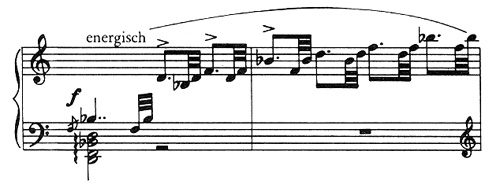
A lyrical theme, derived from the material of the orchestral introduction, now makes its appearance in an effective pianistic setting. The Steiner edition marks this theme espressivo; while this marking is missing in the excerpt in the method, Hummel indicates the theme's character clearly enough in his annotations with two terms that appear to hold a special significance in his vocabulary: gesangreich und ausdruckvoll, or in translation, lyrical and expressive (Ex. 4).
Ex. 4. Gesangreich und ausdruckvoll.

In the case of the passage work which succeeds the seven-measure statement of this songlike theme, the composer calls for a somewhat brighter tempo and a more rhythmic delivery: "von hier an etwas gehender und markirter" (Ex. 5).
Ex. 5. von hier an etwas gehender und markirter.
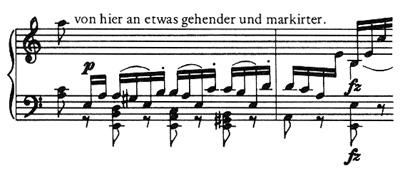
A new theme is now introduced that is special to the soloist's part alone and may be viewed from an analytical standpoint as a composite of the opening rhythmic theme of the tutti (Ex. 1) and the subsequent lyrical answer noted in Example 4. It is at this point that the Steiner edition adds a marking of cantabile. Though the excerpt in the method omits that direction, Hummel more than makes up for the omission in his annotations; the tempo which was picked up only 14 bars earlier is now held back once again, and the composer recommends that this theme be performed in a manner "etwas zurückhaltend, und gesangreich," or holding back somewhat and lyrically. He had good reason to hold back, for this theme marks the glory of the Concerto in A Minor; it is only incidental to its merit that it is probably also to serve as inspiration for the opening piano solo theme of Chopin's Concerto in E Minor as well (Ex. 6).
Ex. 6. etwas zurückhaltend, und gesangreich.
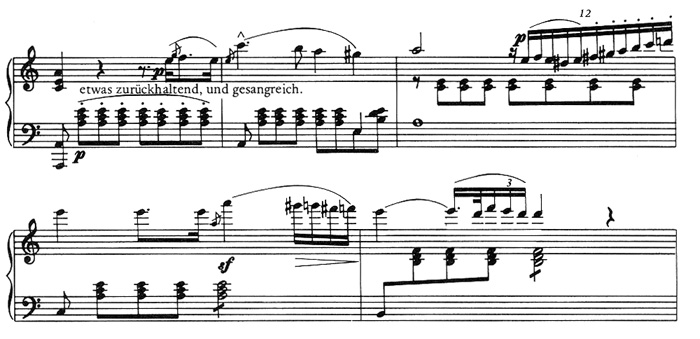
Forward movement is resumed once again in the transitional figuration to be seen in Example 7, ("etwas vorwärtsgehend")
Ex. 7. etwas vorwärtsgehend.
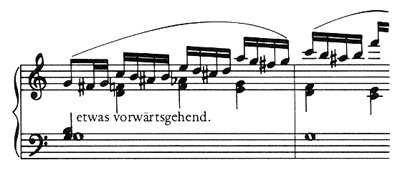
and this in turn serves to introduce the second theme in the relative major key of C (Ex. 8).
Ex. 8. Der Mittelsatz etwas zurückhaltend und mit zartem Gefühl.

A theme of operatic flavor anticipating Bellini (interestingly enough, Hummel's desire to obtain Bellini's autograph is recorded in the correspondence of his late years), this theme is marked dolce in both Steiner and in the method reprint. But in his annotations, Hummel supplements this marking for what he terms his "middle subject" with a call for restraint in tempo and delicacy in feeling: "der Mittelsatz etwas zurückhaltend und mit zartem Gefühl." On the other hand, the composer calls for a faster tempo and a spirited delivery for the fanfare motive (marked risoluto in both Steiner and the reprint) that follows only 9 bars later ("schneller und mit Geist"). This portion of the score is illustrated in Example 9.
Ex. 9. schneller und mit Geist.
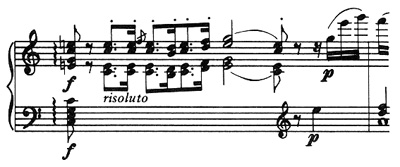
The succeeding cadential close (Ex. 10) is to be performed in a relaxed fashion according to the composer's annotation, "so as to prepare for its resolution into the next main idea."
Ex. 10. etwas nachgebend, als Vorbereitung zum Tonfall in die Hauptpassage.

This latter idea or Hauptpassage—consisting of some 46 bars of cadenza-like material which concludes the exposition—is to be delivered "in one and the same tempo, with fire, right up to the conclusion of the solo."
Turning now to Hummel's Exhibit B, we find the composer proposing to illustrate the principle of both ritard and accelerando. For an example of ritard he refers to the recapitulation portion of the first movement of his concerto and excerpts the 10 measures that precede the resumption of Tempo I in the coda. Here he calls for a relaxation of tempo ("nachgebend") as the movement approaches the transitional idea that will lead into the coda proper. For this idea, marked sempre più sostenuto e ritardando al morendo in the reprint (Ex. 11), Hummel plots an elaborate scheme of deceleration in his annotated remarks: "von hier aus noch nachgiebiger, gedehnter immer mehr und mehr endlich ganz langsam."
Ex. 11. nachgebend.
sostenuto.
von hier aus noch nachgiebiger gedehnt.

As Tempo I is reached (Ex. 12) he calls on the player to attack the original tempo with fire and hold it thus, right to the end: "Das erste Haupttempo mit Feuer ergreifend, und so fort bis an's Ende."
Ex. 12. Das erste Haupttempo mit Feuer.
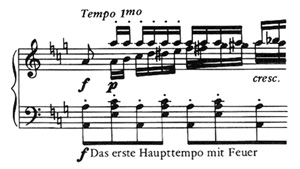
Hummel includes a reminder at the bottom of this page that all relaxation of tempo within the measures affected by these short lyrical reprieves must occur almost imperceptibly ("muss fast nur unmerklich geschehen") without dragging the movement down to that of an adagio. It must be done in such a manner, he says, that the differentiation between the holding back and the urging forward will never appear too striking in comparison to the basic tempo ("so, dass der Abstand zwischen dem Zurückhalten und dem Vorwärtsgehen nie zu auffallend gegen das Haupttempo erscheint").
Hummel's Exhibit C contains an excerpt from the first solo section of the second movement of the concerto, and many of the annotated portions of these excerpts are shown in Example 13.
Ex. 13a. Hummel Concerto in A Minor, Excerpts from second movement—Larghetto.
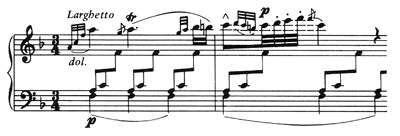
Ex. 13b. anmerklich zurückhalten
delicato.

Ex. 13c. kräftig.
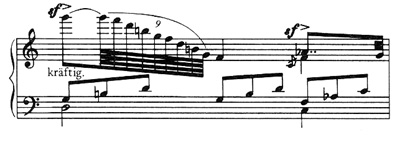
Ex. 13d. leicht.

Ex. 13e. risoluto
leggiero.
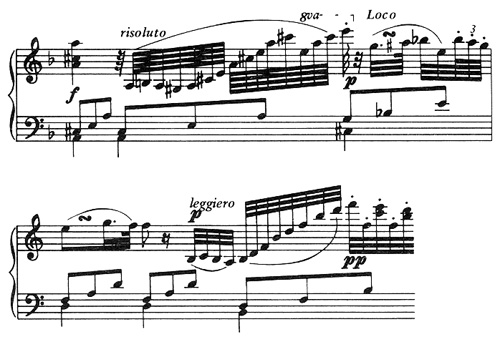
13f. zart.

13g. marcato
rasch und kräftig.

13h. smorz. in tempo
etwas im Tempo anhaltend, um das Ohr gleichsam auf den Hauptschlussfall vorzubereiten.

In the case of this movement, the original Italian markings which Hummel included in the first edition of his score are to be seen in the large print; and their resemblance to those one might find in a score by Chopin—the second movement of his Concerto in E Minor, to cite but one example—is striking, indeed; markings such as dolce, delicato, leggiero, marcato, risoluto, and smorzando. But the composer's comments in German on the sense of these markings are of interest, too, for the additional light they throw on the way this terminology was to be understood.
For instance delicato calls for a barely noticeable holding back ("unmerklich zurückhalten"), probably the same restraint that is implied in the typical Chopin delicato. For the rest, the remaining characterizations scattered throughout this portion of the score are noteworthy for the extremes in contrast which they suggest. Zart (delicate) is appended to a group of thirty-second notes marked pianissimo; leicht (light) is recommended for a filigree-like scale passage in contrast to rasch und kräftig (fast and forceful) for the brilliant sweep of a forte arpeggio. A final comment, inserted below the original direction of smorzando, elaborates on the meaning of that term: "holding back the tempo somewhat so as to prepare the ear, as it were, for the final cadential resolution" ("etwas im Tempo anhaltend, um das Ohr gelichsam auf den Hauptschlussfall vorzubereiten").
In summary, the various examples presented here may be evaluated in different ways. Taking Hummel's remarks on performance alone and starting with the last of his three "themes," one might easily be led to the conclusion that they are hardly all that provocative and do not contribute much additional information to what we already know. For instance, the prototypes of an allegro or an adagio performance are to be kept separate and distinct, the execution of the former must never be allowed to cross the point where it might be confused with the latter, and what is good for the one is generally harmful to the other.
We would find somewhat more substance in those remarks which touch on his "second theme" of moderation and pertain to the liberties which the composer deems not only permissible in a good performance but even indispensable to it. Certain deviations from a basic tempo must be introduced, for example, within the performance of an allegro movement in order to accommodate the delivery of a lyrical theme. But on the other hand, deviations of this sort must never be exaggerated; they must always conform to the requirements of what we might term Hummel's "Laws of Moderation"—as must all those aspects of performance which can be positively summarized in words.
More intriguing than what Hummel tells us in words about the qualities of a good performance are those qualities which he claims (in his opening categorizations) are entirely beyond the realm of words. For example, it is futile to attempt to verbalize regarding those characteristics which determine a "beautiful" or an "expressive" performance. "Allgemeine Kunstworte" are as good as useless for the person who does not already have an understanding of the musical values involved; they are superfluous for the true musician who otherwise carries within his person a "natural" instinct for musical meaning. What is more, it is this innate musical understanding which alone will enable a performer to communicate "was der Komponist für das Gefühl in sein Werk hat."
Considered in conjunction with his annotations in his musical excerpts, these negative aspects of Hummel's analysis of the problems and qualities of performance assume a striking new significance. For in his annotations Hummel actually compromises his stated position concerning the futility of verbalization in the first place and makes the attempt, through them, to lead his reader on to a proper understanding of his precise wishes with regard to the performance of this score. In comparison to the almost total silence of the urtext presentation—four markings, at the most, in about as many pages of music, in the case of his first exhibit—we are treated to what amounts to a veritable torrent of words. Furthermore, the tempo itself is shifted back and forth within even small segments of the core, the better to accord with the ebb and flow of the music itself and with the spirit that an "expressive" performance might require, nachgebend here, vorwärtsgehend there, and these shifts are called for by the very same personage whose acquaintance we made just previously as the champion of moderation!
Thus we are afforded—in terms unmistakably clear—a detailed picture of the composer's own tempo modifications in his performance of a given composition, tempo modifications which certainly eschewed all exaggeration and which would never allow the act of performance to degenerate to the level of undisciplined fantasy. But fantasy there must have been, too, and here one imagines that Schindler's words concerning the "capricious beauty" that sang out in Hummel's performance could not have been far from their mark.
If a conservative figure like Hummel indulged in freedoms of this sort, what should we expect from a bolder, less conventional person like Beethoven? Must there not have been at least a grain of truth to the characterizations of his performance (in such bad repute today) left us by Schindler? And what about Schubert? Here one thinks of Hummel's own admiration for Schubert's performance, almost ranking it superior to his own compositions!
Perhaps the information that Hummel has given us in the annotations should prove even more crucial to our proper understanding of the early nineteenth-century musical score in general. On the basis of a comparison of those annotations with the urtext we should be made acutely aware of how much the composers of the period may have taken for granted in notating their scores. On this occasion Hummel saw fit to elaborate on this matter and in doing so, he has provided us with what we referred to earlier as a rare glimpse into the dark and uncertain worlds beyond the authority of the urtext. But he also set a precedent for a tradition, and subsequently we find others stepping in to do for the composer what composers themselves refrained from doing: a Bülow in the nineteenth century adding expressive markings and interpretive comments to Beethoven, and a Schnabel in our own time explaining phrase construction and suggesting tempo deviations. Perhaps all this spurious activity is deplorable, but as we return to the pristine purity of our urtexts, should we not reconsider—on the basis of what we have learned from Hummel—not only the limits of urtext authority, but its possible limitations as well?
Regardless of the questionable esteem in which his writing is generally held today, Schindler appears to have grasped the central issues involved here when—in connection with what he termed the "free performance of piano music in the musical period just past"—he wrote:
Hummel's remarks on the alternation of the rhythm in the Cantilena of his great concerto in A minor are examples that may serve as a model. The fact that these remarks do not appear in the score of the work itself but in his Klavierschule which was written later, is one more illustration of the way in which those masters presupposed a knowledge of expressive playing on the part of the virtuosi of their day.17 (Italics mine.)
The review of Hummel's remarks and examples tends to confirm the aptness of Schindler's summary. Today's performing artist who ponders the sense of these issues may well be led to a more authentic approach not only by Hummel's own music, but also to much of the music of Hummel's time, including that of his three great contemporaries: Beethoven, Schubert, and Weber. Our teachers have an important mission in this regard, too. They can see to it that their charges—by gaining an understanding of the tradition implied in Hummel's commentaries—need not rely solely on what Berlioz termed "the frozen stiffness of the metronome" in their interpretations of their prized urtext scores.
1Johann Nepomuk Hummel, Ausführlich theoretisch-practische Anweisung zum Pianoforte Spiel (Vienna: Haslinger, 1828). The Concerto in A Minor, Opus 85 was first published by Steiner, circa 1821 (cf. Joel Sachs, "A Checklist of the Works of Johann Nepomuk Hummel," Notes XXX, No. 4 [1974], 741).
2Hummel's association with Beethoven must have begun with outright rivalry shortly after his return in 1793 to Vienna, where as he states in his autobiographical sketch, he assumed "front rank as a performer." (Quoted in Karl Benyovszky, J.N. Hummel: der Mensch und Künstler [Bratislava: Es-Verlag, 1934], pp. 199-202). The association was to end years later in the same city, with Hummel's loyal attendance on Beethoven during the latter's final days.
Hummel's early instruction with Mozart is well known. In his autobiographical sketch he tells us that ''as far as the piano was concerned, I became my own master [at age 9] following Mozart's instruction." With regard to Schubert, Hummel is quoted as having said that he "almost admired Schubert's playing even more than his compositions." Cf. Otto Deutsch, Schubert: Memoirs by His Friends (New York, 1958), pp. 37-39. For his part, Schubert expressed the desire—never fulfilled by his publishers—of dedicating his last three sonatas to Hummel. Cf. Deutsch, The Schubert Reader (New York, 1947), pp. 810-11. But years before their meeting, there was the case of Schubert's modeling his Trout Quintet on Hummel's Septet in D Minor, Opus 74 (also recorded in Deutsch, Memoirs, p. 148). To realize the extent of this influence, one has only to compare the second theme of the Trout Quintet, first movement, with the corresponding theme of the Septet.
3Dieter Zimmerschied, Thematisches Verzeichnis der Werke von Johann Nepomuk Hummel (Hofheim, 1971), pp. 206-208.
4Anton Felix Schindler, Beethoven As I Knew Him, translated by Constance Jolly, edited by Donald W. MacArdle (London, 1966), p. 380.
5Quoted in Joel Sachs, Kapellmeister Hummel in England and France (Detroit, 1977), p. 96.
6François-Joseph Fétis, Biographie universelle des musiciens, 2nd ed. (Paris, 1874), Vol. 4, p. 388.
7Robert Schumann, Gesammelte Schriften (Leipzig, 1914), Vol. 1, p. 11.
8In its original one-volume format as issued by Haslinger, Hummel's method weighs five pounds and is in three parts. Each part is divided into subsections (Abschnitte) and these sections in turn are subdivided into chapters. The chapters are divided into numbered units, sometimes comprising several paragraphs and sometimes consisting of a single paragraph, or even a single sentence. From beginning to end the language of the method is quaint and its presentation thorough. The first chapter opens with an explanation of where the student is to sit at the piano, and the final chapter—on free improvisation, nearly 500 pages later—is concluded with the author's account of how he was able to overcome his fears "vor einem Publikum von 2-3000 Zuhörern zu phantasiren." Part I of the method is devoted to an exposition of the rudiments and includes some 60 Pieces for Practice, some of them of great charm, expressly written by the author to illustrate principles previously expounded. Part II is primarily concerned with the mechanics of playing and contains over 1,000 hypothetical keyboard figurations designed for the conscientious student's daily drill and practice (perhaps a single glance at this portion of the work alone would have sufficed to have aroused Beethoven's disgust). Part III, the shortest, includes chapters on a variety of topics, such as the use of the pedal, the purposes and uses of the metronome, the characteristics of the various makes of pianos, the art of improvisation, the realization of ornaments and the execution of the trill, and finally the chapters on performance with their accompanying musical illustrations under discussion here.
9Hummel, pp. 417-18. Unless otherwise noted, the quotes that follow are taken from these pages in the method.
10Louis Adam, Méthode de piano (Paris, n.d.), p. 105.
11Quoted in Harold C. Schonberg, The Great Pianists (New York, 1963), p. 110.
12Hummel, p. 439.
13Weber's words are quoted as they are given in the Bülow edition of the Beethoven sonatas published by Schirmer, Vol. III, p. 637. "The time (tempo) should be no trip-hammer, tyrannically restraining or urging forward, but rather, in a composition what the pulse is in man. . . . There is no slow tempo in which passages do not occur that demand a more rapid movement, to avoid a sensation of dragging, nor is there any presto which does not equally require by way of contrast a tranquil execution of certain passages, that it may not be deprived, by overhaste, of the resources of expression."
14Hummel's advice regarding a stress on the "downbeat notes in passages" (i.e., involving groupings of triplets or four sixteenth notes) parallels that given by Moscheles in the introductory remarks to his Etudes, Opus 70. Chopin's use of accent marks over similar groupings in his études (for example, the first one in C Major) should probably be understood in the same light.
15I have consulted a number of first, or early editions of Hummel's works held in the Library of Congress to verify the authenticity of the various expression markings that one finds in more recent editions of those works. In general there is a fair consistency between the original printings and the later reprintings. While early works like the three fugues of his Opus 7 (circa) 1799 include barely a single marking, the Fantasia in E-flat, Opus 18 (circa 1805) already features a richly varied vocabulary. The authenticity of this vocabulary itself is doubly confirmed in a holograph copy of the Piano Concerto in A-flat Major of 1827, likewise in the Library of Congress.
16The Steiner edition of the concerto is also in the Library of Congress.
17Schindler, p. 412.
